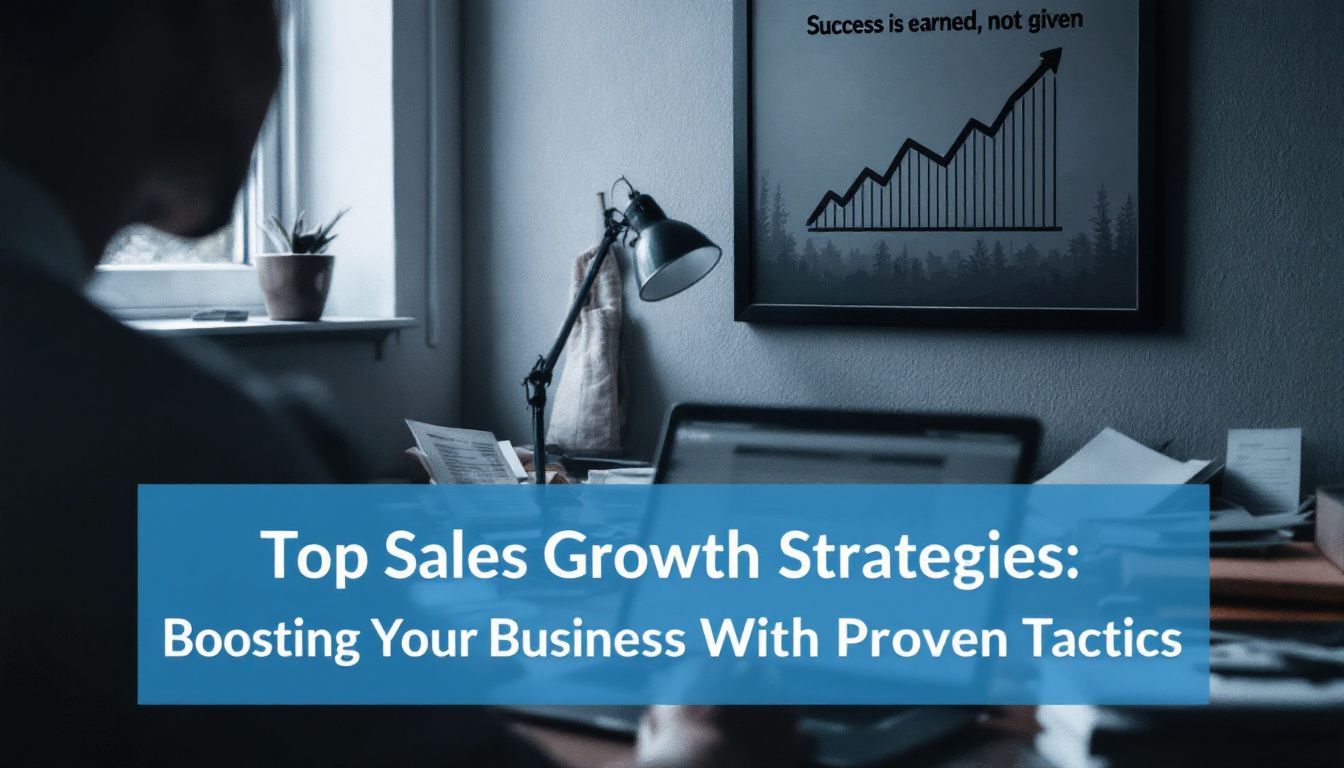Are you struggling to boost sales, but your methods just aren’t clicking? Many of us have faced this challenge. After thorough market research, I’ve found reliable Sales Growth Strategies that help businesses succeed by exploring new channels.
In this blog, you’ll learn simple ways to attract more customers, connect with current ones, and improve your sales team’s results. Keep reading—you won’t want to miss these helpful tips!
Key Takeaways
- Businesses that focus on customers spot needs quicker, earn higher profits, and build loyal fans who happily recommend them.
- A clear sales funnel—ads, useful content, regular follow-ups—is vital; without effective CRM tools, 79% of leads never buy.
- Using several sales channels helps companies grow 25% faster, according to Deloitte’s 2023 research—Nike partnering with Amazon back in 2017 is a good example.
- Sales and marketing teams do best when they share clear goals and meet regularly; also, content that speaks directly to customers lifts engagement as much as 74%.
- Subscription services keep booming—growing 200% every year—while people enrolled in loyalty programs shop three times more often than one-time buyers.
Top Sales Growth Strategies: Boosting Your Business With Proven Tactics

I’ve found these sales growth tactics work time and again for businesses of all sizes. Let me share some proven methods that can help you boost your numbers fast and create lasting success.
Understand your customers and their needs
Putting customers first helps my business grow faster. Businesses with close customer ties tend to innovate more—and make bigger profits. Knowing exactly what customers need isn’t just helpful—it actually drives growth.
Market research lets me spot customer needs early, even before they’re clearly expressed. Too many companies out there skip this step, pushing products that nobody asked for.
Research consistently shows customer-focused businesses come up with more fresh ideas. And innovation matters—it’s the link between understanding customers and growing sales. I regularly chat with buyers to find out what’s bugging them.
Then I shape my products or services to tackle those actual issues. Doing this builds loyalty and turns satisfied buyers into fans, who then spread good words and bring in new clients.
Use the sales funnel to optimize the customer journey
Sales funnels act like clear roadmaps, leading people from strangers to loyal buyers. Each step nudges them closer—casually guiding them to a purchase. Here’s how I approach it:
- Build awareness through ads and social media posts—making sure people easily find my products.
- Write helpful blogs to show I get their issues and build their interest naturally.
- Give free guides or demos that let customers explore benefits without pressure.
- Streamline the final choice with clear pricing, simple checkout, and fast answers to questions.
- Check data to see how many move through all funnel stages and pinpoint any weak spots.
- Run A/B tests on landing pages—keeping versions that boost clicks and sales.
- Follow up by email with visitors who checked things out but didn’t buy yet.
- Set retargeting ads to remind visitors about products they looked at, but left behind.
- Encourage return visits by sending thank-you notes and casual check-ins after purchases.
- Request feedback to understand what’s working and quickly spot areas for improvement.
- Review monthly sales data to spot trends and smartly tweak the sales funnel.
- Coach my sales team clearly on what to say at every funnel stage, keeping language direct and helpful.
Leverage customer relationship management (CRM) tools
I’ve watched CRM tools totally reshape how I approach sales. All my customer info—in one simple spot. Easy to follow leads, stay connected, and build stronger ties. My team even saw a 30% jump in conversions once we started using CRM software!
And the stats back this up—about 79% of marketing leads don’t convert without effective CRM systems. A good CRM helps me understand customer needs clearly, simplify the sales steps, and boost customer happiness.
CRM software gives me easy-to-follow KPIs. I quickly notice patterns, identify issues early, and make smarter choices based on clear facts. The right CRM connects marketing and sales smoothly—from first touch to final buy.
Fewer lost leads, more happy, loyal customers.
Expand into new distribution channels
Once you have your CRM set up, it’s time to find fresh ways to reach more customers. Brands often see huge gains by adding new sales channels. A Deloitte study from 2023 confirms this—companies with multiple channels had customer growth rates 25% higher than the rest.
Nike offers a good example here; back in 2017, they partnered with Amazon, quickly gaining access to millions of online shoppers.
A solid first step is a quick look at your current channels. Maybe try selling directly to your customers—or join online marketplaces to extend your reach. My advice: partner up with popular e-commerce platforms to put your products in front of more eyes.
This approach helps small stores and bigger companies grow quickly, win more customers, and boost sales.
Tap into local market expansion opportunities
Growing my business locally gave me big results. Customers prefer products matching their unique tastes and needs. IKEA learned this lesson entering India—adapting furniture to smaller spaces and local styles boosted their success.
I also saw sales soar once I customized my offerings to each area’s preferences. That small move made connecting with new buyers much easier.
Small pilot campaigns help test fresh sales ideas—saving money and effort. I team up with local companies who deeply understand their markets. With their local insight, I quickly discover what customers really want.
These partners often spot emerging trends I might overlook. A smart local growth strategy creates loyal customers and increases sales without taking big risks.
Marketing and Sales Alignment for Growth
I’ve seen huge sales jumps when my marketing and sales teams work as one unit. Your teams need to speak the same language and share the same goals to truly boost your bottom line.
Integrate marketing campaigns with sales goals
I keep marketing plans aligned with sales targets by holding regular team meetings. These cross-team chats let us set common goals and agree on how we’ll measure success. My sales crew shares exactly what customers ask for—this helps marketing craft useful materials for closing deals.
Marketing folks then put together emails, social media ads, and web pages focused clearly on these customer needs. Working closely like this raised the return on investment for both sales and marketing.
My best campaigns result from sales and marketing teams openly sharing data about customer problems. Knowing these issues helps us shape clear messages customers actually care about.
Our emails, social posts, and website content all point clearly to shared sales objectives. This teamwork cuts wasted money and boosts our ability to seal deals. With shared analytic tools, both teams quickly spot issues and tweak tactics right away.
Utilize social media for lead generation and engagement
I use social media every day to meet new customers and drive more sales. Platforms like Facebook, Instagram, and LinkedIn help me reach people interested in my products. Quick videos, useful guides, or simple tips—these grab attention and turn casual viewers into leads.
Through these posts, I build real trust with my audience, step by step. But organic reach can only go so far… so I also use paid ads to expand my audience. Smart targeting means I reach exactly those folks likely to want my products, offering sign-up deals and special promos that collect names and emails.
Social media also lets me chat directly with my customers, answering their questions quickly and honestly. This personal touch beats traditional marketing every time—people appreciate genuine connections.
Free resources like eBooks, cheat sheets, or webinars draw in leads easily. My followers give their email addresses in exchange for helpful content, and just like that, I’ve brought in a new lead.
Best of all—I see clearly which posts and ads perform best through easy-to-use analytics built into each platform.
Create web content targeted at your audience
My website’s content speaks right to my ideal customers. I create blogs, videos, and guides that solve real, everyday issues my audience faces. Quality content draws visitors in—and keeps them coming back for more.
Every post stays closely aligned with their actual needs and common struggles. Good content marketing connects the right people, at just the right moment.
Check the numbers—personalized content can lift engagement rates by as much as 74%. I’ve seen great results by mixing core SEO strategies with topics that directly answer common customer concerns—even before they’re asked.
This builds trust naturally and helps prospects move smoothly through my sales funnel. Now let’s look at some fresh, creative sales tactics that can take your business even further.
Innovative Sales Techniques to Drive Results
I’m always on the hunt for fresh ways to boost sales results. New tactics can shake up your sales game and bring in more money fast.
Implement account-based selling strategies
I put my energy into high-value accounts—those most important for my business. Account-based selling helps me create plans customized for each target company, rather than using one general pitch for everyone.
My team creates content that speaks to each company’s specific issues, addressing exactly what’s on their minds. This works better than broad marketing efforts—companies that use ABM report higher ROI and shorter sales cycles.
Choosing the right accounts is crucial, and keeping my entire team aligned around shared goals makes a big difference. Many sales reps notice that personal touches—those small details—often seal the deal with large clients.
Offer membership programs or subscriptions
Subscription models made a big difference in my business. The numbers speak clearly—this market is growing at 200% each year! Customers appreciate monthly boxes, memberships, and access plans.
Subscriptions offer steady income, keeping clients loyal and coming back. Free trials are great to attract new people without any pressure.
Using email systems helps me connect easily with subscribers, share updates, and offer discounts. Many loyal buyers began with a quick, easy trial. Tools like WPFunnels simplify the signup experience for newcomers.
And here’s what’s great—adding subscriptions boosted my income stability noticeably. Long-term members usually spend more money over time compared to single-purchase customers.
Develop referral and loyalty programs
I use referral programs—with rewards for both sides—to quickly grow my customer base. Clients earn points for inviting friends, and new members get a special welcome offer. This two-sided approach works wonders for sales.
Loyalty programs are another great way to boost repeat business. Members often spend more each visit and shop more often in general. To add excitement, I include fun features like badges and progress bars—customers love tracking their progress.
In fact, my data shows loyalty members shop three times more often than one-time customers.
These programs turn satisfied customers into active promoters. They become my strongest sales force, building lasting relationships while driving steady revenue growth.
Measuring and Optimizing Sales Performance
Tracking your sales numbers helps you spot what works and fix what doesn’t – I’ll show you how to use sales data to boost your team’s results and grow your bottom line in the next section.
Monitor sales analytics and trends
I track sales data to improve my business decisions. Data shows me what works and what needs to change in my sales approach.
| Sales Analytics Focus | Business Impact |
|---|---|
| Regional Sales Performance | Helps target high-growth markets and adjust resources |
| Conversion Rate Tracking | Shows where leads drop off in the sales process |
| Real-time Insights (via Talligence) | Allows quick responses to market changes |
| AI-Enhanced Analysis | Boosts decision quality and sales team output |
| Performance Metrics | Creates better sales forecasts and team management |
Sales numbers tell a clear story about customer needs. Each metric gives me specific insights into what drives revenue growth. The data points to real actions my team can take today.
Many companies see up to 15% growth after setting up proper sales tracking systems. My focus stays on numbers that matter rather than getting lost in too much data.
Reevaluate pricing strategies and product bundling
Pricing can really boost your sales if done right—smart choices and bundles mean bigger orders and more satisfied buyers. Here’s what works for me:
- Keep an eye on market shifts and adjust prices accordingly. Last year, just tweaking my pricing to match what people were happy to pay raised sales by 15%.
- Regularly compare prices with competitors who offer products like yours. I do this so I stay competitive but don’t undersell myself.
- Get feedback directly from customers on pricing. Honest customer input shows me clearly if they feel they’re getting their money’s worth.
- First test new prices on smaller customer groups. Trial runs always help me know what’s effective before rolling out major price adjustments.
- Make bundles that directly address typical customer issues. My buyers appreciate deals on products they often use together—and prefer them over buying separately at full price.
- Provide different pricing levels to meet various customer budgets. Having basic, standard, and premium options means folks can pick what fits best.
- Set seasonal prices to boost sales during slow seasons. Giving summer discounts draws people during months that used to drag for me.
- Review your prices at least once every three months. Quick quarterly check-ups let me notice pricing patterns or market shifts fast.
- Track the bundles customers buy most often, and find out why they’re popular. This insight helps me decide what bundles stay, change, or go.
- Check how price changes affect customer loyalty—to find that ideal balance between earning profit and keeping buyers coming back.
Next, we’ll cover how effective training can help turn your sales team into high-performing pros.
Conduct regular sales training and upskilling
I invest in ongoing sales training to boost my team’s skills—in fact, our company saw a 3% rise in quota achievements after starting effective programs.
- Run monthly skill workshops to keep selling methods fresh, practical, and directly tied to customer issues and product details.
- Do role-play exercises for practice in handling tricky customer questions—my team feels ready and confident after rehearsing calls before real meetings.
- Invite industry experts to speak on current market shifts, sales tactics, and trends—outside speakers often bring valuable insights we might overlook.
- Build a collection of successful recorded sales calls—watching actual calls helps team members easily spot what clicks with our customers.
- Measure training value by tracking sales before and after each training session—businesses with strong sales coaching achieve about 94.8% of their revenue goals.
- Match new sales reps with seasoned mentors—they get to shadow top sellers directly, which cuts their learning curve significantly.
- Teach sales reps basic data analysis—knowing how to spot key selling patterns helps my team target the tactics that perform best.
- Focus training around actual customer needs—teams trained this way have an 84.9% rate of success, as they learn to ask smarter questions and actively listen to buyers.
- Provide short digital learning options like videos or mobile apps—this way, busy team members can train quickly between appointments.
- Run fun sales contests to test the new skills, with small prizes for using ideas from training—friendly competition gets people excited, trying fresh tactics.
Now, let’s measure and track sales results to pinpoint clear areas for growth.
Conclusion
Boosting your sales is all about smart planning, daily actions, and knowing your customers. Pay close attention to how you’re doing, and adjust as you go. Sales tools—like CRM systems—make it easy to manage leads, while new channels open more doors.
Plus, regular team training keeps everyone’s skills fresh and sales steady. These simple steps not only improve today’s results—they set your business up for long-term success.
References
- https://www.emerald.com/insight/content/doi/10.1108/imr-09-2020-0215/full/html
- https://funnelytics.io/optimize/top-strategies-for-optimizing-your-marketing-funnels/ (2024-08-15)
- https://convertica.org/understanding-the-customer-journey-funnel/
- https://www.netsuite.com/portal/resource/articles/erp/crm-strategies.shtml (2023-06-15)
- https://www.articsledge.com/post/market-share-growth-strategies-proven-tactics-for-business-expansion
- https://www.smartling.com/blog/market-expansion-strategies
- https://www.close.com/blog/sales-marketing-alignment
- https://www.gartner.com/en/sales/trends/sales-and-marketing-alignment
- https://blog.storefries.com/social-media-lead-generation/
- https://scholarworks.waldenu.edu/cgi/viewcontent.cgi?article=11753&context=dissertations
- https://www.researchgate.net/publication/381697872_Content_marketing_is_a_strategic_marketing_approach_focused_on_creating_and_distributing_valuable_relevant_and_consistent_content_to_attract_and_retain_a_clearly_defined_audience_ultimately_aiming_to_ (2024-06-25)
- https://ignitevisibility.com/marketing-strategies/
- https://www.o8.agency/blog/master-account-based-marketing-strategy-improve-engagement-and-drive-growth
- https://getwpfunnels.com/subscription-marketing/
- https://blog.propellocloud.com/how-to-increase-subscription-sales
- https://www.linkedin.com/pulse/sales-driven-loyalty-maximizing-revenue-through-customer-y3jbc
- https://www.linkedin.com/pulse/monitoring-sales-performance-data-driven-approach-maximizing-desai-a0otf
- https://paro.ai/blog/reevaluate-your-pricing-strategy/ (2022-04-26)
- https://sbigrowth.com/insights/blog/study-reveals-the-importance-of-sales-training


